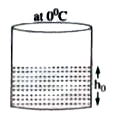Statement I : The coefficient of real expansion of the liquid is independent of the nature of container.
Statement II : γr=γa+γv where γr= coefficient of real expansion, γa= coefficient of expansion and γv= coefficient of apparent expansion of vessel.Solution in Bengali
Statement I is true, statement II is true , statement II is a correct explanation for statement I.
Statement I is true, statement II is true , statement II is not a correct explanation for statement I.
Statement I is true, statement II is false.
Statement is false, statement II is true.
The correct Answer is:B
Step by step video, text & image solution for Statement I : The coefficient of real expansion of the liquid is independent of the nature of container. Statement II : gamma_(r)=gamma_(a)+gamma_(v) " where " gamma_(r)= coefficient of real expansion, gamma_(a)= coefficient of expansion and gamma_(v)= coefficient of apparent expansion of vessel. by Physics experts to help you in doubts & scoring excellent marks in Class 11 exams.
Updated on:21/07/2023Similar Questions
The coefficient of real expansion of liquid is gamma_(R) and the coefficient of appareent expansion of the liquid is gamma_(A) . The coefficient of cubical expansion of the vessel is gamma . If gamma_(R) : gamma_(A) = 4:1 then gamma_(A) : gamma is
View SolutionThe coefficient of real expansion γR of a liquid is 5 times the coefficient of linear expansion of the material of the container in which the liquid is present. The ratio is of the cofficient of apparent expansion and real expansion of the liquid is
View SolutionIf the coefficient of real expansion gamma_(R) is 1% more than coefficient of coefficientg of apparent expansion, linear expansion coefficient of the materia is a
View SolutionThe apparent coefficients of volume expansion of a liquid when heated filled in vessel A and B of identical volumes, are found to be gamma_(1) and gamma_(2) respectively. If alpha_(1) be the coefficient of liner expansion for A, then what will be the be the coefficient of linear expansion for B? (True expansion - vessel expansion = app.exp)
View SolutionThe coefficients of apparent expansion of a liquid when determined using two different vessels A and B are gamma_(1)" and "gamma_(2) respectively. If the coefficient of linear expansion of the vessel A is alpha . The coefficient of linear expansion of the vessel B is
View SolutionThe coefficient of apparent expansion of a liquid when determined using two different vessle A and B are γ1 and γ2, respectily. If the coefficient of linerar expansion of vesel A is α. Find the coefficient of linear expension of the vessel B.
View SolutionUsing two different containers A and B, the coefficients of apparent expansion of a liquid are found to be gamma_(1) " and " gamma_(2) respectively. If the coefficient of linear expansion of the material A is alpha , find that of the material B.
View SolutionThe coefficient of apparent expansion of a liquid for two different vessels A and B are γ1 and γ2 respectively. If the coefficient of linear expansion of the material of the vessel A is α, then the coefficient of linear expansion of the material of the vessel B will be
View SolutionIF the coefficient of volume expansion of a solid, a liquid and a gas are gamma_s,gamma_l and gamma_g respectively then
View SolutionIf the coefficient of real expansion gamma_(r) is 1% more then coefficient of apparent expansion, linear expansion coefficient of the material is
View SolutionPassage-II:
Coefficient apparent expansion of a liquid is γH=mass excelled (remaining mass) ( change in temperature)
In the above question coefficient of apparent expansion of the liquid is
View SolutionIf γR,γAandγV represent the coefficient of real expansion of a liquid, coefficient of apparent expansion, n of the liquid and coefficient of cubical expansion of the material of the vessel respectively, then which of the following is/are correct?
View SolutionPassage - II :
Liquids do not have definite shape and size, they are taken in a vessel. Their expansion (or) contraction takes place with respect to the container in which they arc considered. The volume coefficient of expansion relative to the vessel is termed as coefficient of apparent expansion (γa) and the volume coefficient of expansion of the liquid is termed as absolute (γRorγL). In some of the arrangements mentioned as per the instructions. solve the problems.
The height of the liquid column in the cylindrical container is h0 at 0∘C. If the temperature of the liquid raises to 0∘C, assuming the coefficient of volume expansion of liquid and solid as γLandγS respectively, the height of the liquid in the vessel (hθ) as a function of temperature (θ) is

View SolutionIf the coefficient of real expansion gamma_(r) is 1 % more then coefficient of apparent expansion, linear expansion coefficient of the material is
View SolutionThe coefficient of apparent expansion of a liquid when determined using two different vessle A and B are γ1 and γ2, respectily. If the coefficient of linerar expansion of vesel A is α. Find the coefficient of linear expension of the vessel B.
View Solution
